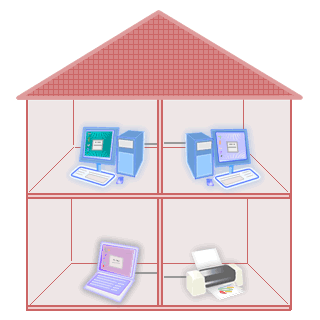Home Networking Guide : Introduction

Picture: Home Network
Connected computers and printer in a home network.
Home networking is about connecting computers,
peripherals,
or other devices in the home. With home networking, you and your family members can (among other things):
- share files, folders, drives.
- share printer or other peripherals.
- share an Internet connection.
- play a multiplayer game.
- share and stream movie or music collections.
- monitor your front door with a camera to see who is coming.
Almost everyone is familiar with connecting a printer or other
peripherals to a computer but this home networking guide starts with
this type of "network" because it can lead to the
understanding of how a home network works.
Then if you have two computers, there are several choices for
direct connection.
If you have more than two computers at home, it's time to look for
a real home networking solution using technologies such as
Ethernet, wireless LAN (Wi-Fi), phoneline networking (HomePNA),
and
powerline networking (HomePlug).
If you have different types of networks, there is a way to
unite the networks so they can work like one network. If you want
to connect your home network to the Internet, several
configurations are available for sharing a single Internet
subscription by multiple computers or devices.
Since networking products vendors want to make home networking
easier for consumers, they bundle networking products in an
all-in-one package or a kit. Even if you are a
non-techie you can install your own network with a home networking kit.
And networking technologies keep growing so in the near future they
will be more likely integrated with consumer electronic
devices to make it even easier for consumer use. Nevertheless,
understanding basic networking principles will be better in
the long run especially when you want to expand your network or
when problems arise.
|